Valladolid
| Valladolid | |||
|---|---|---|---|
| — Municipality — | |||
|
|
|||
|
|||
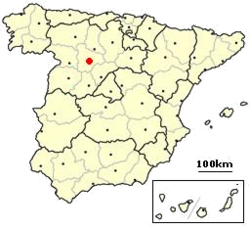 |
|||
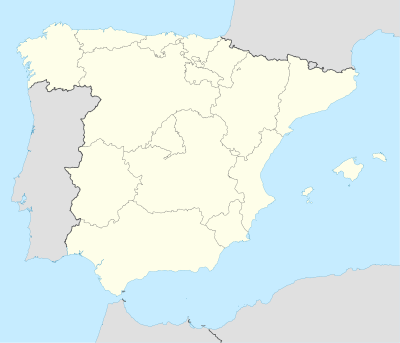 Valladolid
|
|||
| Coordinates: | |||
| Country | |||
| Autonomous community | |||
| Province | Valladolid | ||
| Comarca | Campiña del Pisuerga | ||
| Judicial district | Valladolid | ||
| Founded | 1072 | ||
| Government | |||
| - Alcalde | Francisco Javier León de la Riva (2007) (PP) | ||
| Area | |||
| - Total | 197.91 km2 (76.4 sq mi) | ||
| Elevation | 698 m (2,290 ft) | ||
| Population (2009) | |||
| - Total | 317,864 | ||
| - Density | 1,606.1/km2 (4,159.8/sq mi) | ||
| Demonym | Vallisoletano, -a (informalmente, pucelano, -a) | ||
| Time zone | CET (UTC+1) | ||
| - Summer (DST) | CEST (UTC+2) | ||
| Postal code | 47001 - 47016 | ||
| Dialing code | 983 | ||
| Official language(s) | Spanish | ||
| Website | Official website | ||
Valladolid (Spanish: [baʎaðoˈlið]) is a historic city and municipality in north-central Spain, upon the confluence of the Pisuerga and Esgueva rivers, and within three wine-making regions: Ribera del Duero, Rueda and Cigales. It is the capital of the province of Valladolid and of the autonomous community of Castile and Leon.
Contents |
Etymology
One suggestion for the origin of Valladolid's name comes from its sounding something like the Arabic name "BaladulWalid" (بلد الوليد) meaning The City of Walid in memory of one of the Ummayad dynasty's greatest caliphs in Damascus; but no good reason has been given as to why the Moors should have given such a grand title to what was then just a little village on a remote and much contested frontier of their empire. A more likely suggestion is a conjunction of the Latin: VALLIS, "Valley", and Celtic: TOLITUM, "place of confluence of waters. Ruins of a Roman settlement have been found in the area and the area was occupied by Celtic tribes when it was conquered by the Romans. Another suggestion is valla ("fence" in Spanish) "de" (of) Olid (Spanish family name).
It is also popularly called Pucela, a nickname whose origin is not clear, but probably refers to a few knights who accompanied Joan of Arc. Another theory tells that it was called Pucela because Puzzeli's cement was sold there, the only city in Spain that did.
History
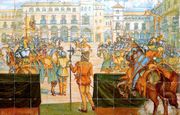
Remains of Celtiberian and of a Roman camp have been excavated near the city. The nucleus of the city was originally located in the area of the current San Miguel y el Rosarillo square, and was surrounded by a palisade. Archaeological proofs of the existence of three ancient lines of walls have been found.
During the time of Moorish rule in Spain the Christian kings moved the population of this region north into more easily defended areas, and deliberately created a no-mans' land as a buffer zone against further Moorish conquests. Valladolid was captured from the Moors in the 10th century, remaining a small village until king Alfonso VI of Castile onated it to count Pedro Ansúrez in 1072. He built a palace (now lost) for himself and his wife, countess Eylo, the Collegiate of St. Mary and the La Antigua churches. In the 12th and 13th centuries Valladolid grew rapidly, thanks also to the commercial privileges granted by the kings Alfonso VIII and Alfonso X, as well as to the repopulation of the area after the Reconquista.
In 1469 Queen Isabella of Castile and King Ferdinand of Aragon were married in the city; by the 15th century Valladolid was the residence of the kings of Castile and remained the capital of the Kingdom of Spain until 1561, when the city was destroyed by a fire and Philip II, born here, moved the capital to Madrid, starting a period of decadence for Valladolid. In 1506 Christopher Columbus died in Valladolid in a house which is now a Museum dedicated to him. It was made the capital of the kingdom again between 1601 and 1606 by Philip III. The city was again damaged by a flood of the Pisuerga and Esgueva rivers.
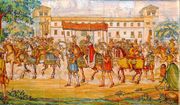
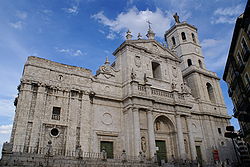
Despite the damage to the old city by the 1960s economic boom, it still boasts a few architectural manifestations of its former glory. Some monuments include the unfinished cathedral, the Plaza Mayor (Main Square), which was the template for that of Madrid, and of other main squares throughout the former Spanish empire, the National Sculpture Museum, next to the church of Saint Paul, which includes Spain's greatest collections of polychrome wood sculptures, and the Faculty of Law of the University of Valladolid, whose façade is one of the few surviving works by Narciso Tomei, the same artist who did the transparente in Toledo Cathedral. The Science Museum is next to Pisuerga river. The only surviving house of Miguel de Cervantes is also located in Valladolid. Although unfinished, Cathedral of Valladolid was designed by Juan de Herrera, architect of El Escorial.
Main sights
The capital of Castile-León preserves in its old quarter heritage of aristocratic houses and religious buildings.
Religious buildings
- The unfinished Cathedral, commissioned by King Philip II and designed by the architect Juan de Herrera in the 16th century. Their respective deaths left the church unfinished and its nave was not opened until 1668. Years later, in 1730, Master Churriguera finished the work on the main front. Inside the cathedral, the great chapel houses a reredos made by Juan de Juni in 1562. The complex is linked to the Diocesan Museum, which holds carvings attributed to Gregorio Fernández and Juni himself, as well as a silver monstrance by Juan de Arce.
- The large Gothic church of Saint Benedict (San Benito), built between 1500 and 1515, with an unusual tower.
- Saint Michael Church (San Miguel), built at the end of the 16th century by the Jesuits, hosts reredos by Gregorio Fernández.
- The façade of the San Pablo Church, characterized by Gothic statues and decoration.
- The Savour (El Salvador) Church, with a façade built around 1550 and a brick tower dating from the 17th century.
The church of Saint James (Santiago) has reredos depicting the Adoration of the Magi (1537) created by Berruguete.
- The Gothic church of Saint Mary the Ancient (Santa María La Antigua) has an unusual pyramid-shaped Romanesque tower from the 12th century.
- The Monastery of Santa María la Real de las Huelgas, originally built in 1600.
- Monasterio de Santa Ana, housing various paintings by Francisco de Goya.
- San Juan de Letrán Church, featuring a Baroque façade built in 1737. Beside this last church is the Monasterio de los Padres Filipinos, designed by the architect Ventura Rodríguez in 1760.
Other buildings
The heart of the old city is the 16th-century Plaza Mayor, presided over by a statue of Count Ansúrez. On one side of it stands the City Hall, a building from the beginning of the century crowned by the clock tower. In the nearby streets is the Palace of Los Pimentel, today the seat of the Provincial Council, is one of the most important, as King Philip II was born in it on 21 May 1527. The Royal Palace, the 16th-century Palace of the Marquises of Valverde, and that of the banker Fabio Nelli – a building with a Classicist stamp built in 1576 – should also be pointed out. The Museum of Valladolid occupies this complex, exhibiting a collection of furniture, sculptures, paintings and ceramic pieces.
The National Sculpture Museum is site in San Gregorio College, a Flemish Gothic style building . It is home to polychrome carvings made by artists like Alonso Berruguete or Gregorio Fernández. The Museum of Contemporary Spanish Art, located in the Herreriano Courtyard, one of the cloisters of the former Monastery of San Benito, preserves more than 800 paintings and sculptures from the 20th century.
The University, whose Baroque façade is decorated with various academic symbols, and the Santa Cruz College, which as well as housing a library forms one of the first examples of the Spanish Renaissance.
The city preserves houses where great historical characters once lived. They include:
- the Casa de Cervantes, where the author of Don Quijote lived with his family between 1603 and 1606. It was in this house where the writer gave his masterpiece the finishing touches.
- The Christopher Columbus House-Museum is located in the residence of the Genoese navigator in the last years of his life. Nowadays the palace exhibits various pieces and documents related to the discovery of America.
- The house where José Zorrilla was born, housing various personal possessions, furniture and documents that belonged to the Romantic writer.
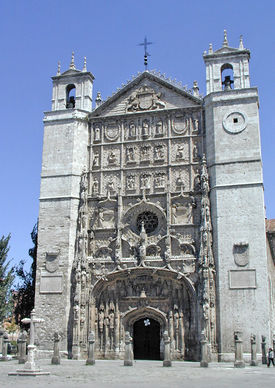
Population
As of the 2004 census, the population of the city of Valladolid proper was 321,713, and the population of the entire urban area was estimated to be near 400,000.
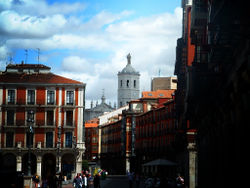
Economy
Valladolid is an economic motor of the autonomous community, having an important automobile industry (IVECO, FASA-Renault, Michelin).
Transportation
There is an airport at nearby Villanubla, with connections to London-Stansted, Paris, Brussels-Charleroi, Milan, Lisbon, Barcelona and Vigo.
Seminci
The city is also host to one of the foremost (and oldest) international film festivals, the Semana Internacional de Cine de Valladolid (Seminci), founded in 1956.
Local cuisine


Although an inland province, fish is commonly consumed. Brought from the Cantabrian Sea, fish like red bream and hake are a major part of Valladolid's cuisine.
The main speciality of Valladolid is, however, lechazo (suckling baby lamb). The lechazo is slowly roasted in a wood oven and served with salad.
Valladolid also offers a great assortment of wild mushrooms. Asparagus, endive and beans can also be found. Some legumes, like white beans and lentils are particularly good. Pine nuts are also produced in great quantities.
Sheep cheese from Villalón de Campos, the famous pata de mulo (mule's leg) is usually unripened (fresh), but if it is cured the ripening process brings out such flavour that it can compete with the best sheep cheeses in Spain.
In the area of bread Valladolid has a bread to go with every dish, like the delicious cuadros from Medina del Campo, the muffins, the pork-scratching bread and the lechuguinos, with a pattern of concentric circles that resemble a head of lettuce.
The pastries and baked goods from the province of Valladolid are well-known, specially St. Mary's ring-shaped pastries, St. Claire's sponge cakes, pine nut balls and cream fritters.
Valladolid is also a producer of wines. The ones that fall under the Designation of Origin Cigales are very good. White wines from Rueda and red wines from Ribera del Duero are known for their quality.
Easter
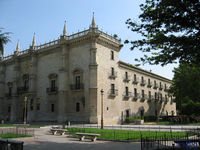
Easter holds ("Semana Santa" in Spanish) one of the best known Catholic traditions in Valladolid. The Good Friday processions are considered an exquisite and rich display of Castilian religious sculpture. On this day, in the morning, members of the brotherhoods on horseback make a poetic proclamation throughout the city. The "Sermon of the Seven Words” is spoken in Plaza Mayor Square. In the afternoon, thousands of people take part in the Passion Procession, comprising 31 pasos (religious statues), most of which date from the 16th and 17th centuries. The last statue in the procession is the Virgen de las Angustias, and her return to the church is one of the most emotional moments of the celebrations, with the Salve Popular sung in her honour.
Easter is one of the most spectacular and emotional fiestas here. Religious devotion, art, colour and music combine in acts to commemorate the death of Jesus Christ: the processions. Members of the different Easter brotherhoods, dressed in their characteristic robes, parade through the streets carrying religious statues (pasos) to the sound of drums and music – scenes of sober beauty.
Sport
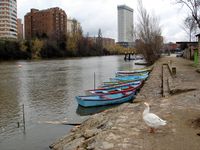
Valladolid is represented in La Liga, the top football (soccer) league in Spain, with their own club, Real Valladolid, or Pucela as they are nicknamed.
CR El Salvador, current champions of Spain's División de Honor de Rugby compete in the European Challenge Cup.
Twin towns - sister cities
 Lille, France
Lille, France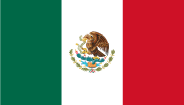 Morelia, Mexico
Morelia, Mexico Orlando, United States
Orlando, United States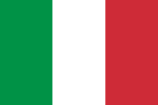 Florence, Italy
Florence, Italy Boston, United States
Boston, United States Lecce, Italy
Lecce, Italy
See also
- Province of Valladolid
- List of municipalities in Valladolid
- English College, Valladolid
External links
Institutions
- Ayuntamiento de Valladolid
- Valladolid's Library
- Culture Foundation
- Tourism in Valladolid province
- City Hall of Valladolid
- University of Valladolid
- Miguel de Cervantes European University
- Fair of Valladolid
- Congress Center of Valladolid
Museums
- Museo de la Ciencia
- Museo Nacional de Escultura
- Museo Casa Cervantes
- Museo Casa de Cristóbal Colón
- Cristóbal Gabarrón Foundation
- Museo Casa de Zorrilla
- Oriental
- Patio Herreriano
Miscellaneous
- Valladolid Town Council International Website
- Internacional Cinema Week - SEMINCI
- Public Transport (buses)
- Holy Week Association of Valladolid
- Valladolid´s photoblog
- Holy Week in Valladolid
- Valladolid Airport
|
|||||||


